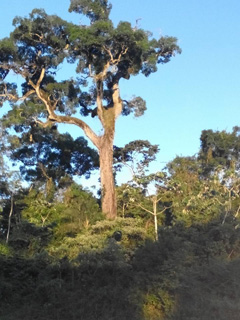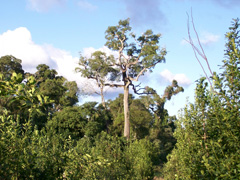 |
|
wikimedia.org |
 |
| flickr User:Eduardo Hildt |
Translate this page:
Summary
Peroba rosa or Aspidosperma polyneuron is an evergreen tree that has an oblong crown and a straight cylindrical bole of up to 90 cm in diameter. The tree can grow up to 8-30 meters in height when fully matured. It functions as both an ornamental tree and a timber tree. The wood is highly valued for its heavy and durable characteristics and is primarily used for general construction. The bark has medicinal uses. It is an astringent and antipyretic.
Physical Characteristics

 Aspidosperma polyneuron is an evergreen Tree growing to 15 m (49ft) by 10 m (32ft) at a slow rate.
Aspidosperma polyneuron is an evergreen Tree growing to 15 m (49ft) by 10 m (32ft) at a slow rate.
See above for USDA hardiness. It is hardy to UK zone 10. The flowers are pollinated by Insects.
Suitable for: light (sandy), medium (loamy) and heavy (clay) soils and prefers well-drained soil. Suitable pH: mildly acid, neutral and basic (mildly alkaline) soils. It can grow in semi-shade (light woodland) or no shade. It prefers moist soil.
UK Hardiness Map
US Hardiness Map
Synonyms
Plant Habitats
Edible Uses
References More on Edible Uses
Medicinal Uses
Plants For A Future can not take any responsibility for any adverse effects from the use of plants. Always seek advice from a professional before using a plant medicinally.
Antipyretic Astringent Bitter
The bark is antipyretic, astringent and bitter[ 739 ].
References More on Medicinal Uses
The Bookshop: Edible Plant Books
Our Latest books on Perennial Plants For Food Forests and Permaculture Gardens in paperback or digital formats.

Edible Tropical Plants
Food Forest Plants for Hotter Conditions: 250+ Plants For Tropical Food Forests & Permaculture Gardens.
More

Edible Temperate Plants
Plants for Your Food Forest: 500 Plants for Temperate Food Forests & Permaculture Gardens.
More

More Books
PFAF have eight books available in paperback and digital formats. Browse the shop for more information.
Shop Now
Other Uses
Furniture Wood
Other uses rating: High (4/5). Other Uses The heartwood is rose-red to orange or yellowish with some darker streaks; the sapwood a dull gray-white[ 409 ]. The texture is fine, compact, but with a rough surface; the grain is straight to interlocked; lustre is bright; there is no distinct taste or odour. The wood is heavy, hard, uniform, with excellent mechanical properties and very durable if kept dry. It works well with hand and machine tools, though it has a moderate blunting effect; it finishes well. An excellent structural timber that is easy to split, it is used primarily in general construction for joinery, veneers, and in the construction of ship decks, flooring, furniture, truck bodies, sleepers etc[ 46 , 349 , 363 , 419 , 719 ].
Special Uses
References More on Other Uses
Cultivation details
Prefers a position with some shade[ 419 ]. Prefers a deep, fertile soil[ 419 ]. A slow-growing tree[ 419 ]. Silvicultural trials have been carried out and in different sites tree heights at 12 - 13 years have ranged from 4.7 to 7.8 metres[ 349 ].
References Carbon Farming Information and Carbon Sequestration Information
Temperature Converter
Type a value in the Celsius field to convert the value to Fahrenheit:
Fahrenheit:
The PFAF Bookshop
Plants For A Future have a number of books available in paperback and digital form. Book titles include Edible Plants, Edible Perennials, Edible Trees,Edible Shrubs, Woodland Gardening, and Temperate Food Forest Plants. Our new book is Food Forest Plants For Hotter Conditions (Tropical and Sub-Tropical).
Shop Now
Plant Propagation
Seed - best sown as soon as it is ripe in a partially shaded position in a nursery seedbed or in individual containers. A germination rate in excess of 70% can be expected, with the seed sprouting within 10 - 20 days. Young plants grow away slowly[ 419 ]. The seed can remain viable for at least 6 months in storage[ 419 ].
Other Names
If available other names are mentioned here
Peroba rosa or Aspidosperma polyneuron
Native Range
SOUTHERN AMERICA: Brazil (Alagoas, Bahia, Espírito Santo, Goiás, Mato Grosso, Mato Grosso do Sul, Minas Gerais, Paraná, Rio de Janeiro, São Paulo), Colombia (Atlántico, Bolívar, Boyacá, Cundinamarca, Magdalena, Sucre, Tolima, Cesar, La Guajira), Peru (Cajamarca), Argentina (Misiones), Paraguay (Alto Paraná, Amambay, Canindeyú)
Weed Potential
Right plant wrong place. We are currently updating this section.
Please note that a plant may be invasive in one area but may not in your area so it's worth checking.
None Known
Conservation Status
IUCN Red List of Threatened Plants Status : Endangered

Growth: S = slow M = medium F = fast. Soil: L = light (sandy) M = medium H = heavy (clay). pH: A = acid N = neutral B = basic (alkaline). Shade: F = full shade S = semi-shade N = no shade. Moisture: D = dry M = Moist We = wet Wa = water.
Now available:
Food Forest Plants for Mediterranean Conditions
350+ Perennial Plants For Mediterranean and Drier Food Forests and Permaculture Gardens.
[Paperback and eBook]
This is the third in Plants For A Future's series of plant guides for food forests tailored to
specific climate zones. Following volumes on temperate and tropical ecosystems, this book focuses
on species suited to Mediterranean conditions—regions with hot, dry summers and cool, wet winters,
often facing the added challenge of climate change.
Read More
Expert comment
Author
M?ll.Arg.
Botanical References
Links / References
For a list of references used on this page please go here
A special thanks to Ken Fern for some of the information used on this page.
Readers comment
| Add a comment |
|
If you have important information about this plant that may help other users please add a comment or link below. Only comments or links that are felt to be directly relevant to a plant will be included. If you think a comment/link or information contained on this page is inaccurate or misleading we would welcome your feedback at [email protected]. If you have questions about a plant please use the Forum on this website as we do not have the resources to answer questions ourselves.
* Please note: the comments by website users are not necessarily those held by PFAF and may give misleading or inaccurate information.
To leave a comment please Register or login here All comments need to be approved so will not appear immediately.
|
Subject : Aspidosperma polyneuron
|
|
|
|